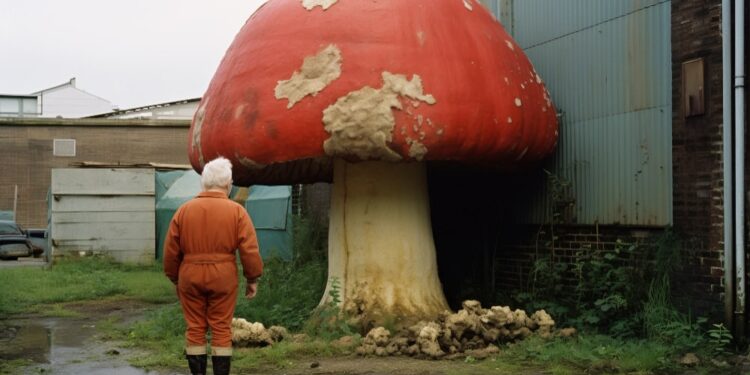Interesting History of Mushrooms and Their Growth Process

Mushrooms are a widely popular type of fungus that has been used in cooking, medicine, and spiritual practices for centuries. They come in various shapes, sizes, and colors, making them a unique and intriguing species. But have you ever wondered about the history of mushrooms or how they are grown?
I remember when I was a child, my grandmother used to tell me stories about how she and her ancestors would go into the forest to forage for wild mushrooms. It always fascinated me how they could identify different types of mushrooms and know which ones were safe to eat. As I grew older, my curiosity about mushrooms only increased, leading me to uncover the fascinating history of this mysterious species.
And today, I’m excited to share with you the history of mushrooms and their growth process.
Related Reading: Top Medicinal Plants, Their Benefits, and Where to Find Them
The History of Mushrooms
Ancient Civilizations
The history of mushrooms can be traced back to ancient civilizations such as Egypt, China, and Greece. In these cultures, mushrooms were highly valued for their medicinal and culinary uses.
Egypt
In Egypt, mushrooms were considered a delicacy and were reserved for royalty. They were also used in medicine to treat various ailments, such as infections and stomach issues.
China
In China, mushrooms were known as the “elixir of life” and were believed to possess healing properties. The Chinese also discovered the cultivation process of mushrooms, making them one of the first civilizations to grow them commercially. They were also the first to use mushrooms in their cuisine, incorporating them into dishes such as stir-fries and soups.
Greece
In Greece, mushrooms were believed to have magical powers and were associated with the gods. They were commonly utilized in religious ceremonies and rituals. The ancient Greeks also recognized the medicinal properties of mushrooms, using them to treat various illnesses.
The Middle Ages
During the Middle Ages, mushrooms were popular in European cuisine and were often served at feasts for the wealthy. However, they were also associated with witchcraft and were deemed as “evil” by the Catholic Church. This belief led to the persecution of people who used mushrooms in their practices, causing a decline in their popularity.
17th and 18th Centuries
It was in the 17th and 18th centuries that mushrooms regained their status as a highly valued food source. French royalty, including King Louis XIV, were known to have a preference for mushrooms and had dedicated gardens solely for growing them.
Today
Today, mushrooms are widely consumed around the world and are recognized for their nutritional value and health benefits. They continue to be an important part of various cuisines and are even used in modern medicine to treat illnesses such as cancer. The cultivation process of mushrooms has also become more advanced, making them easily accessible to people all year round.
You may Need: How Do Psychedelics Treat Depression?
How Mushrooms are Grown
Now that we know about mushrooms’ history let’s examine their cultivation process. This delicate and complex process requires precise conditions and techniques.
Spawn Production
The first step in growing mushrooms is the production of spawn. Spawn can be described as mushroom “seeds” that are used to start the growth process. This can be done by either purchasing ready-made spawns or creating your own through a process called “spawning.”
Substrate Preparation
Once the spawn is obtained, it is added to a substrate or growing medium. This can be a variety of materials such as compost, sawdust, or straw. The substrate is then sterilized to remove unwanted bacteria or fungi that may compete with the mushrooms for nutrients.
Inoculation and Incubation
After the substrate is prepared, it is inoculated with the spawn and placed in a dark, humid environment. Yes, mushrooms thrive in dark and damp conditions. The incubation process can take anywhere from 2-4 weeks, depending on the type of mushroom being grown.
During this time, the mycelium (the vegetative part of the fungus) will grow and spread throughout the substrate. This is an essential step, providing the necessary nutrients for the mushrooms to grow.
Fruiting and Harvesting
Once the mycelium has fully colonized the substrate, it is time for the mushrooms to “fruit.” This is when the mushroom caps start to form and grow. The environment must be carefully controlled during this stage, with specific temperature, humidity, and lighting conditions.
In just a few weeks, the mushrooms reach the perfect stage for harvesting. They are typically picked by hand and can be done multiple times, depending on the type of mushroom.
Conclusion
Mushrooms have a fascinating history that spans centuries. From their use in ancient civilizations to being a popular food source and medicine today, mushrooms have come a long way. The cultivation process of mushrooms is also complex and intriguing, making it a highly valued commodity.
So, the next time you see or taste a mushroom, remember its rich history and the intricate process of growing it. And maybe try your hand at growing some yourself.
Some Tips for Identifying Wild Mushrooms
As mentioned earlier, my grandmother and her ancestors were skilled at identifying wild mushrooms. However, it takes years of experience and knowledge to safely identify them. Here are some tips to get you started if you’re interested in foraging for wild mushrooms:
- Always consult a professional or an expert before consuming any wild mushroom.
- Research and learn about the different types of mushrooms in your area.
- Pay attention to the environment where the mushrooms are growing, as certain types thrive in specific conditions.
- Look for identifying features such as color, shape, and texture of the mushroom cap and stem.
- Be cautious when trying new mushrooms and only eat small amounts at first to test for any reactions.
FAQs
How long does the cultivation process take for mushrooms?
The cultivation process can take anywhere from 2-4 weeks, depending on the type of mushroom being grown.
What are the origins of mushroom consumption?
Mushrooms have been consumed by ancient civilizations such as Egypt, China, and Greece for medicinal and culinary purposes.
Are mushrooms still associated with witchcraft?
No, they were associated with witchcraft during the Middle Ages but are now widely recognized for their nutritional value and health benefits.
Can I grow my own mushrooms at home?
Yes, you can grow your own mushrooms at home by following proper techniques and using the right materials.
How are mushrooms typically harvested?
Mushrooms are typically picked by hand when they reach maturity.
What is the role of mycelium in mushroom growth?
Mycelium provides necessary nutrients for mushroom growth by colonizing and spreading throughout the substrate.
Can you harvest mushrooms more than once?
Yes, depending on the type of mushroom, they can be harvested multiple times after a few weeks of initial fruiting.






